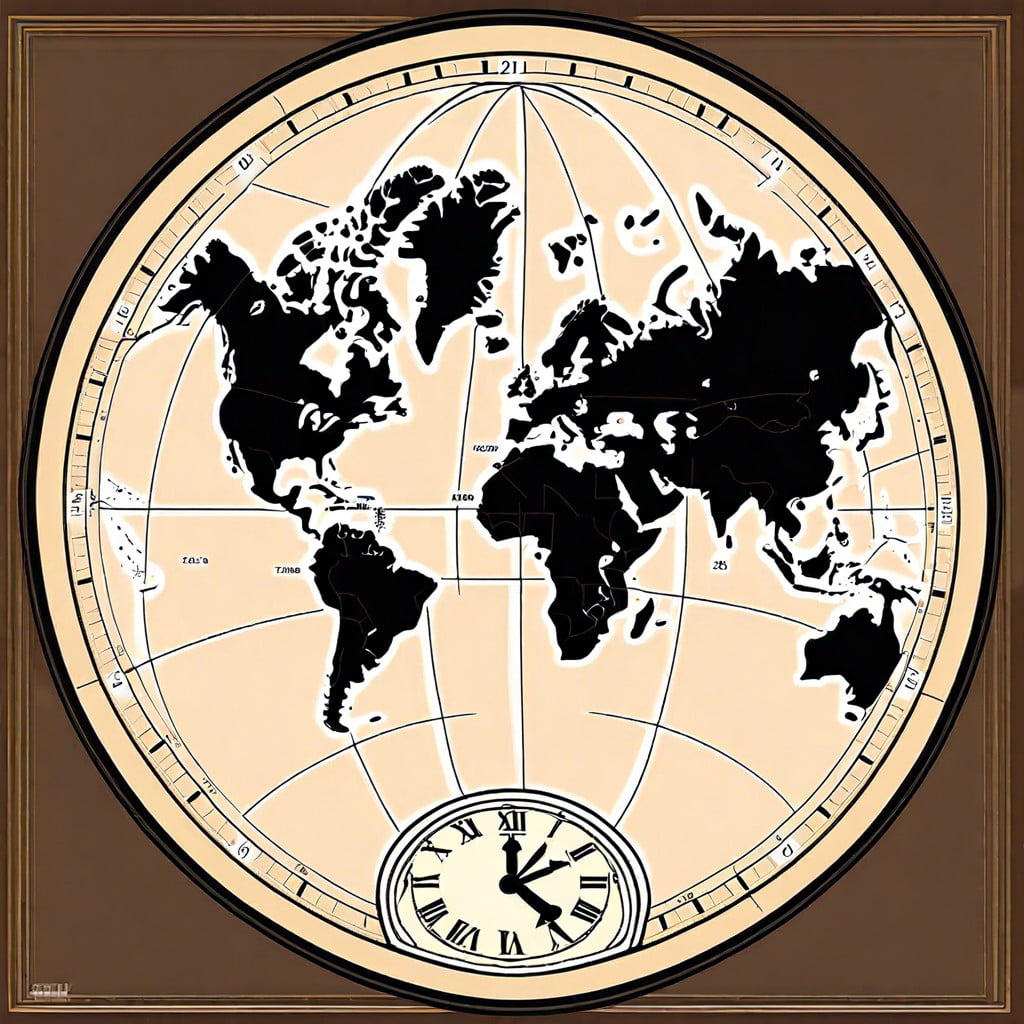Last updated on
Dealing with the concept of calculating time can often feel daunting, but it need not be, because this article simplifies it by taking you step by step through the process of determining what time it will be eight hours from now.
Calculating time adjustments, such as adding 8 hours to the current time, can often seem straightforward until one confronts the complexities of time zones, the nuances of Daylight Saving Time, and the precision offered by coordinating with Universal Time Coordinated (UTC) or Greenwich Mean Time (GMT).
Whether you’re scheduling a meeting across different regions, setting a reminder for an event, or simply syncing with a global event, understanding these elements is crucial to ensure accuracy.
This article serves as a comprehensive guide to navigating these factors, providing detailed steps to determine what time it will be 8 hours from now—with consideration to standard versus daylight time—and how to adjust calculations when the time span crosses into the next day.
Armed with this knowledge, you’ll be well-equipped to make precise time calculations no matter where you are or what time-related challenge you may face.
Key takeaways:
- Time Zones: Different time zones have different local times.
- Daylight Saving Time: DST can affect the calculation.
- UTC/GMT Reference: Convert local time to UTC/GMT for precise calculations.
- Standard vs. Daylight Time: Be mindful of the switch between standard and daylight time.
- Adjusting for Next Day: When adding 8 hours surpasses midnight, the calculation extends into the next day.
Understanding Current Time Zone and Daylight Saving Adjustments

To accurately calculate time adjustments, such as adding 8 hours to the current time, it’s essential to first consider the time zone you are in. Different geographic locations abide by specific time zones, each potentially having a different standard time. Additionally, many regions observe daylight saving time (DST), which shifts the clock forward by one hour during warmer months to extend evening daylight. This shift can affect the calculation:
- Time Zones: The Earth is divided into 24 time zones. Knowing your local time zone is crucial because 8 hours later in one zone will not be the same local time as 8 hours later in another.
- Daylight Saving Time: If you are within a period or location observing DST, this may advance the clocks, causing a one-hour shift. Check if DST is in effect and whether it will begin or end within your 8-hour calculation window.
- UTC/GMT Reference: Coordinated Universal Time (UTC) or Greenwich Mean Time (GMT) serves as a standardized reference. For precise calculations, consider converting your current local time to UTC/GMT first, then adding 8 hours, and converting back if necessary.
- Standard vs. Daylight Time: Be mindful if during your 8-hour span, there may be a switch from standard time to daylight time or vice versa.
Remember, adding 8 hours to the current time could potentially involve crossing into a different day or even a different time zone if you plan to travel. Check whether the resulting time falls on the following day, and adjust the date accordingly.
Determining Current Time

To accurately project a time 8 hours into the future, the first step is identifying the exact present time. This can typically be done through several means:
- Digital Devices: Smartphones, computers, tablets, and digital clocks inherently display the correct time, often synchronized via the internet or network providers.
- Analog Watches and Clocks: For individuals using these, ensure they are properly set by comparing with a reliable source, such as a time signal from a radio station or a trusted time-keeping service online.
- Official Timekeeping Services: Websites such as time.gov provide precise time based on your location and time zone, a valuable reference for manual calculations.
Consider synchronizing your timepiece with a standard time service to ensure the accuracy of your starting point before adding the 8-hour interval.
Adding 8 Hours to Current Time
To calculate the time that is 8 hours from now, begin by looking at a clock or your device for the current time. Record this as your starting point. For instance, if the current time is 2:00 PM, adding 8 hours would bring you to 10:00 PM.
Here are the steps to follow:
- Identify AM or PM: Note whether it’s the morning (AM) or evening (PM) to correctly maintain the time of day after adding hours.
- Add Hours Directly: For an expedient result, add the hours directly to the current time. If the hour figure is less than 12 after addition, the time will remain in the same AM or PM period.
- Calculate Overlap into Next Period: When the sum exceeds 12, convert the time into the next AM or PM period. For example, if the current time is 11:00 PM and you add 8 hours, the resulting time would be 7:00 AM of the following day.
- Adjust if Crossing Midnight: If the addition spans past midnight, note that you’re heading into the next calendar day. This is crucial for setting alarms or making plans.
- Maintain the Minute: If your starting time includes minutes, say 2:45 PM, ensure you preserve those minutes when adding the 8 hours. Thus, 2:45 PM plus 8 hours would be 10:45 PM.
Hour (Military) Time Format
The 24-hour clock, commonly known as military time, simplifies time calculation without the need for AM or PM designations. Here’s how to add hours using this format:
Start with the current time in a four-digit format where the first two digits represent the hour and the last two the minutes.
To calculate 8 hours ahead, simply add 8 to the hour component.
If the sum exceeds 23, subtract 24 to reset the hour count, indicating a new day.
For example, if the current time is 1500 (or 3:00 PM), adding 8 hours would result in 2300 (or 11:00 PM). If the time were 2200 (or 10:00 PM), adding 8 hours would lead to 0600 the next day.
Remember to adjust the minutes as needed—adding 30 minutes to 1545 would result in 1615.
Practice with different times to become more proficient with the 24-hour format and time calculations.
Hour (AM/PM) Time Format
Using the 12-hour time format involves distinguishing between morning and evening times with the “AM” and “PM” indicators. “AM” stands for “ante meridiem” which means “before midday,” and “PM” stands for “post meridiem,” which indicates “after midday.”
To calculate time 8 hours ahead in a 12-hour format:
- Note the current time and determine whether it is AM or PM.
- Add 8 to the current hour.
- If the sum is 12 or less, keep the same AM/PM designation.
- If the sum is more than 12, subtract 12 from the total to find the new time and switch the AM/PM designation.
- Remember that when you move from AM to PM or vice versa, you are passing noon or midnight, respectively.
For example, if it’s 10:00 AM now, adding 8 hours would result in 6:00 PM. However, if it’s 10:00 PM, adding 8 hours brings you to 6:00 AM the next day. Keep in mind that crossing from PM to AM denotes the start of a new day.
Adjusting for Next Day
When adding 8 hours to the current time surpasses midnight, the calculation extends into the next day. Here are essential points to keep in mind:
- Cross-reference the current time with the 24-hour clock to simplify the calculation.
- Remember that the day changes at 00:00 (12:00 AM), so if the addition of hours goes beyond 23:59, it is time to shift to the following calendar date.
- In a 12-hour clock format, when the time calculation transitions from PM to AM, it indicates a move to the next day.
- Note the number of hours beyond midnight to determine the exact time for the next day. For example, if the current time is 10:00 PM, adding 8 hours brings you to 6:00 AM the next day.
Always review for accuracy, especially if the calculation is for time-sensitive commitments or appointments.
Time Zone Considerations
When calculating the time 8 hours from the present moment, it’s crucial to consider the impact of time zones especially if the calculation spans across different geographical areas. Each time zone corresponds to a specific region and the local time can differ significantly.
- Be aware of your local time zone: Knowing whether you are in Eastern, Central, Mountain, or Pacific time, among others, is the first step.
- Understand the time zone difference: If you’re coordinating with someone in a different time zone, account for their time relative to yours; this might involve adding or subtracting hours.
- Factor in Daylight Saving Time (DST): Areas that observe DST will have their clocks adjusted during certain months, which can affect the calculation.
- International considerations: If dealing with international time zones, it may span across more than just a few hours’ difference, and can often involve a different date.
- Use time zone converters: Online tools are available to easily translate the future time into the corresponding local time of any world region, considering all necessary adjustments.
Keeping these points in mind, it ensures precision in scheduling across different time zones without the risk of miscommunication or missed appointments.
Use of Online “Hours From Now” Calculator
Online calculators designed to determine time hours from now offer a quick and user-friendly solution. Upon visiting such a website, you typically enter the current time and specify the number of hours to add. The calculator then instantly provides the exact future time, accounting for AM and PM transitions. These tools are particularly beneficial for those not accustomed to 24-hour time format calculations or when dealing with time-sensitive tasks requiring precise time management.
Additionally, the calculators adjust for any changes that could occur if the resulting time crosses midnight, ensuring accuracy even when the calculation spans into the next day. They serve as reliable aids for international communication, travel planning, or scheduling across different time zones, as some calculators also factor in these variances.
Manual Calculation Vs. Automated Tools
Manual calculation involves a straightforward process of adding the desired number of hours to the current time. For an 8-hour increment:
- Check the current time.
- Add 8 to the hour component.
- If the sum exceeds 24 (in 24-hour format) or 12 (in 12-hour format), subtract the maximum possible to determine the correct hour and account for any change in AM/PM designation.
- Carry over to the next day if necessary, understanding that crossing midnight shifts the date.
Automated tools simplify this process:
- Input the current time into an online calculator.
- Specify the number of hours to add.
- The tool automatically accounts for day changes and provides the resulting time instantly.
- Some tools also adjust for time zones and daylight saving time if relevant information is provided.
By choosing either method, one can accurately determine the time 8 hours from the present. Manual calculations enhance understanding of time concepts, while automated tools offer convenience and speed.
Illustrative Example: 8 Hours From Now Calculation
To solidify the concepts discussed, let’s walk through a practical scenario. Imagine the current time is 2:00 PM.
First, note whether it’s AM or PM and how many more hours remain in the day. Since it’s 2:00 PM, there are 10 hours until midnight.
Now, add 8 hours to the current time: 2:00 PM + 8 hours = 10:00 PM.
Thus, in 8 hours, it will be 10:00 PM on the same day.
If the starting point were 2:00 AM instead, adding 8 hours would result in 10:00 AM, still on the same day.
In case the current time were later in the day, say 10:00 PM, adding 8 hours would carry over to the next day: 10:00 PM + 8 hours = 6:00 AM.
Always remember to account for the change from AM to PM (or vice versa), and when adding hours that extend past midnight, acknowledge the transition to the next day.
Related:




